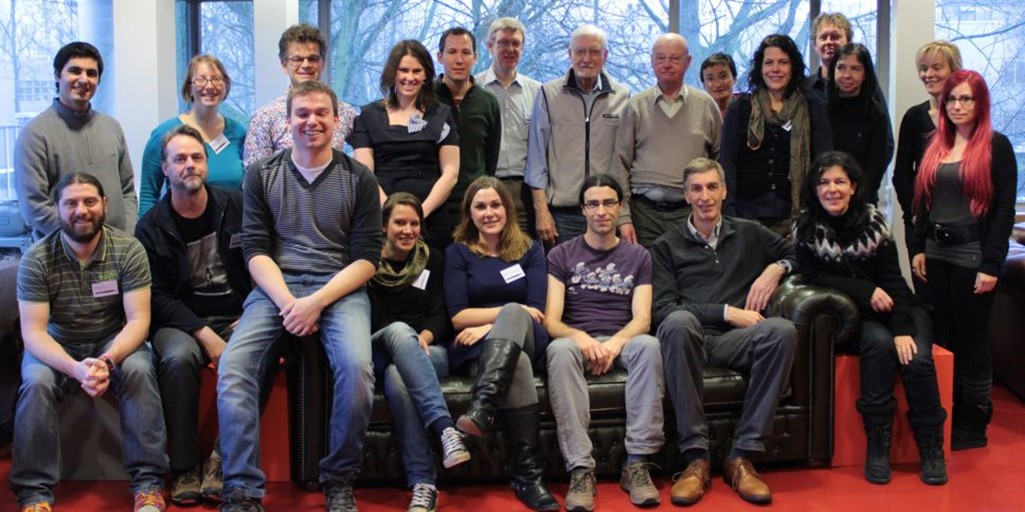Theodore D. Kemper, 1926-2024
On January 17 2024, Theodore D. Kemper passed away. I consider him to be one of the great minds of science. Allow me to present his life and work briefly.
Theodore D. (Dave) Kemper was born in Brooklyn, NY, USA, on 29 December 1926, and received his degree in English from the City College of New York in 1949. After working as a writer for Metropolitan Sunday Newspapers, he returned to school for a PhD in sociology. From 1973, he has been attached to St. John’s University, New York. A fuller obituary can be found at Dignity Memorial.

A social interactional theory of emotions, 1978
Kemper had a wide-ranging, inquisitive mind and a style of writing that was both eloquent and analytically precise. His first book was a fat volume in which he postulated a new, sociological theory of emotions. In fact, he ranged from physiology to psychology to sociology. His theory deals with all emotions, in all situations: love, fear, anger, hubris, depression… He distinguishes emotions that relate to social structures, that result from anticipation, and that result from past events.
Two relational channels
The causes for emotions, says Kemper, come from two relational channels: voluntary compliance with others’ wishes or the “status channel”, and involuntary compliance or the “power channel”.
For instance, after a status elevation – perhaps after graduating - a person might feel happy. In anticipation of receiving no status – perhaps after a loved one died – someone might become depressive. When in love, one wants nothing but to confer status on the loved one. When in friendship, one knows that the friend can be relied on to confer status.
A ground-breaking book
This book, in my opinion, should have become a major bestseller, shaping the course of the social sciences, just like my father’s book that appeared two years later. Kemper perceives the kaleidoscope of human affairs, and is able to trace a clear path through it, that shows a deep truth about human sociality. Not only that, but anyone wanting to know how an author should properly discuss the works of others, and how to relate their own work to it, can take this book (Kemper, 1978) as an example.
Unfortunately, it seems that Kemper was too far ahead of the troops. His book was discussed, admired, but also dismissed by sociologists. It was adopted by practitioners though. My own second-hand copy is from the “Department of Mental Health, Institute for Juvenile Research”, in Chicago, Illinois, USA.
Social Structure and Testosterone , 1990
In this book (which I have not yet read), Kemper shows the theoretical implications of empirical work on testosterone. In human males, testosterone levels rise after a victory or status elevation, while falling after defeat or status demotion. For me, as a biologist having read many works on animal behaviour, this is no surprise. Has any of you ever felt horny after a major success?
Here again, Kemper was ahead of the troops. Ethologists such as Robert Sapolsky (baboons) or Frans de Waal (primates) can talk about these things, but social scientists? Many people shrink back at the acceptance of being great apes. I expect that the 21st century will turn out to be a century of biology in the social sciences – but at the same time as our biology as eusocial mammal is being brought to light, new cages for the mind are being erected, so that the verdict is still out.
Status, Power, and Ritual Interaction, 2011
Although his obituary writes that Kemper turned to playwrighting since 2007, he could not resist further writing about his status-power theory, to which he had now added the important concept of “reference group”. A Kemperian reference group does not need to be a group in the usual sense of the word. It could be one’s deceased dad, or a book, or an influencer, or a deity. One’s organism is also a reference group.
Reference group meeting
Kemper comes up with an original concept: the “reference group meeting”. Whenever one faces a choice, all one’s reference groups meet virtually and may raise a voice. This holds for even the smallest of choices, often taken subconsciously: Will we smile first, return a smile, speak, answer, kiss, hit, touch, turn away?
This book is the first I read of him, in 2011. It bears the subtitle “A Relational Reading of Durkheim, Goffman and Collins”. Indeed, I found that his coherent status-power theory allowed him to improve on the interpretative powers of these three eminent sociologists.
Love and friendship
At first, I had some trouble getting my head around “status” as a kind of relational gift that people confer on one another and crave, along with something that one can “have” in the public eye. What really won me over is his discussion on love and friendship. This was no dry science. Here was a man coming to grips with the heart and soul of life (Kemper, 2011).
In fact I was so impressed that I contacted him by email. He turned out to be still active, very kind, and very sharp-witted. We talked about how his theory and my father’s work on culture could be brought into conversation.
I wrote a blog about status-power theory a few years ago: status and power make the world go round.
Kemper and Hofstede: complementary theories
To give a brief idea, Kemper charts the relational world of which Hofstede describes the variability across groups. Kemper states that we are always trying to maintain our relationships in terms of status-power constellations with our reference groups. Hofstede describes how this differs across the units into which we are born and raised. In its briefest form (Hofstede, 2013), here is how dynamics of status, power and reference groups differ across dimensions of culture:
Collectivism - Individualism
This dimension of culture specifies the social unit of status-power dynamics. Individualistic cultures tend towards extraversion, individual pride and guilt. Collectivist cultures tend towards group loyalty, collective pride and shame.
Power distance
This dimension specifies how much respect is due to people depending on their position in society, and how much power accrues to people of high status. In large power distance culture, those in positions of status expect to wield power, and so do those in lower positions. In small power distance cultures, status does not entitle one to power usage, and there is separation of powers.
Femininity - Masculinity
This dimension specifies how much status accrues to powerful people, and to powerless people. In a masculine culture, the powerful are accorded status: heroes, warriors, bullies. Power displays, also figurative ones, are expected from leaders. In feminine cultures, the powerless are given status: children, the needy, the biosphere. Leaders tend to hide their power.
Uncertainty avoidance
This dimension specifies how strictly codified are the unwritten rules for status exchanges (i.e. rituals small and large). In a culture of strong uncertainty avoidance, there is anxiety about transgressing status-power rules, which thus become highly ritualized. As a consequence, rules serve a ritual more than a practical purpose. In a culture of weak uncertainty avoidance, rules are only created if they serve a practical purpose.
Long-term vs Short-term orientation
This dimension specifies to which extent, and through what rituals, status-power configurations are mutable. A short-term oriented culture tends to assume fixed status-power constellations, and to employ elaborate rituals for changing these. A long-term oriented culture tends to assume change and balance across status-power constellations.
Indulgence versus Restraint
This dimension specifies the voice of the organism in the reference group meeting. Faced with the choice between duty and relaxation, the norm in restrained cultures will tend towards duty, and in indulgent cultures it will tend towards relaxation.
Knowing the rules vs mastering the game
There is of course so much more to say about the links between Hofstede’s and Kemper’s theories. Just like knowing the rules of chess is by no means enough to be able to play the game, knowing the essence of these theories is by no means enough to be able to understand the game of life. Recently, I created an “Artificial Sociality Manifesto” with a few other authors, that contains literature pointers (Hofstede et al., 2021).
Emergence of the Glass Ceiling, 2013
This is not a book title, but a project I did with other researchers. When in 2013 I was awarded a fellowship at the Netherlands Institute for Advanced Studies for a project about investigating the emergence of the glass ceiling among primary school children, I invited Kemper for a workshop. In January 2014, he made me a huge status conferral by visiting our group, along with my father Geert, and both gave guest lectures.

The group picture shows participants to the NIAS-Lorentz workshop on “The Emergence of the Glass Ceiling”, Leiden, January 2014. Dave Kemper and Geert Hofstede are 7th and 8th from left, standing.
Elementary Forms of Social Relations, 2017
The 2014 workshop was about computational social simulation and in particular, modelling human motivation and behaviour. I flatter myself that Kemper was so inspired by his experience with our research community that he came up with another book. This one is a slender volume subtitled “status, power, and reference groups” that simply sums up his theory, with a view to serving a general audience, including potential users such as us computational social simulation people (Kemper, 2017). Since then, my students and I have been using Kemper’s work for creating the sociality of computational agents in our models.
I have been corresponding with him, until his health began to give out. He was, to me, what the French call a “maître à penser”, and what he himself would call an important reference group.
Read him!
His works have lost none of their relevance. He deserves, not just not be remembered, but to be widely read in the 21st century.
For my part, I am working now on a book that further integrates Kemper’s and Hofstede’s theories. Stay tuned.
Literature
Hofstede, G. J. (2013). Theory in social simulation: Status-Power theory, national culture and emergence of the glass ceiling Social Coordination: Principles, Artefacts and Theories, Exeter. http://www.scopus.com/inward/record.url?eid=2-s2.0-84894173186&partnerID=MN8TOARS
Hofstede, G. J., Frantz, C., Hoey, J., Scholz, G., & Schröder, T. (2021). Artificial Sociality Manifesto. Review of Artificial Societies and Social Simulation (RofASSS), 4(8). https://rofasss.org/2021/04/08/artsocmanif/
Kemper, T. D. (1978). A social interactional theory of emotions. John Wiley & Sons.
Kemper, T. D. (2011). Status, Power and Ritual Interaction: a Relational Reading of Durkheim, Goffman and Collins. Ashgate.
Kemper, T. D. (2017). Elementary Forms of social Relations: Status, power and reference groups Routledge.